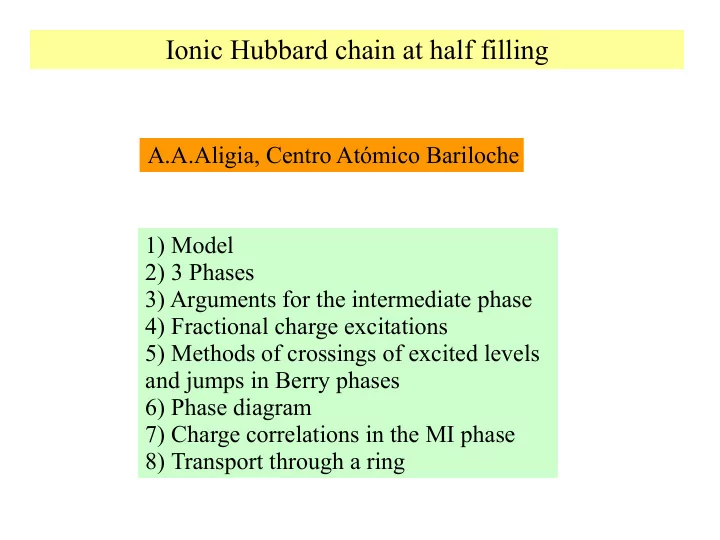

Ionic Hubbard chain at half filling A.A.Aligia, Centro Atómico Bariloche 1) Model 2) 3 Phases 3) Arguments for the intermediate phase 4) Fractional charge excitations 5) Methods of crossings of excited levels and jumps in Berry phases 6) Phase diagram 7) Charge correlations in the MI phase 8) Transport through a ring
The model: Interest: 1) Neutral-ionic transition in mixed-stack donor-acceptor organic crystals ...DADADA… (Avignon, Balseiro, Proetto, Alascio, Phys. Rev. B 33, 205 (1986)) 2) Ferroelectric perovskites (Egami et al., Science 261, 1307 (1993), R. Resta and S. Sorella, Phys. Rev. Lett. 74, 4738 (1995), Fabrizio, Gogolin, Nersesyan, ibid 83, 2014 (1999))
Phases of the model: t<< U - 2 Δ MI Δ Mott insulator J - Δ J = 2 t 2 /( U - 2 Δ )+2 t 2 /( U + 2 Δ ) Δ t<< 2 Δ - U BI Band insulator - Δ t > 2 Δ - U BOW or SDI
Arguments for the existence of the intermediate SDI phase a) bosonization (Fabrizio et al.) b) Mapping to an SU(3) AF Heisenberg (Batista-Aligia) 1) Electron-hole transformation at sites with energy - Δ 2) Elimination of doubly occupied sites 3) Mapping of the remaining three states into an SU(3) spin Inclusion of nearest-neighbor repulsion V
SU(3 ) S=1 |11>
Method of crossings of excited levels (weak coupling): For critical systems: Then, crossing of two excited levels denotes a change of phase S = 1, k = 0, P = -1 MI or SDW Spin transition S = 0, k = 0, P = 1 B i BOW or SDI S = 0, k = π , P = -1 Charge transition BI or CDW S = 0, k = π , P = 1 OPEN SHELL BC
Method of jumps of Berry phases (strong coupling): ... 0 1 2 L -1 Charge Berry phase g: phase captured by the ground state in the cycle 0 < Φ < 2 π a) � In systems with inversion symmetry g = 0 or π (mod. 2 π ) b) � Changes in polarization Δ P = Δ g( e /2 π ) BI or CDW g = 0 MI or SDW g = π
Spin Berry phase g s Δ =0, V =1 Both methods coincide!!
Phase diagram
d =2 Δ S. Manmana et al.
S. Manmana et al.
Charge-charge correlation functions in the MI phase r - 3 ln -3/2 r
r - 3 ln -3/2 r
Measuring the charge transition j φ L = 4 n weak links Mapping to an effective Anderson
φ B>>T K
Intensity of the first peak in the transmittance
Intensity of the first peak in the transmittance
Conductance effective Anderson G 0 = 2 e 2 /h w~ A R.L.Width w proportional to quasiparticle weigth A
Conclusions The transition from the BI tothe MI takes place through an intermediate dimerized ferroelectric phase The topological jumps allow to determine accurately the transitions Charge correlations in the MI phase have power law decay due to relevant coupling between charge and spin The topological transition can be measured in nanodevices or molecules
References: Phase diagram : M.E. Torio, A.A. Aligia, and H.A. Ceccatto, Phys. Rev. B 64, 121105 (2001) (Rapid Comm) Dimerized phase : C.B. Batista and A.A. Aligia, Phys. Rev. Lett. 92, 246405 (2004) ; Phys. Rev. B 71, 125110 (2005). Charge dynamics in the MI phase : A.A. Aligia, Phys. Rev. B 69, 041101(R) (2004) (Rapid Comm.) Transport through a ring : A.A. Aligia, K. Hallberg, A.P. Kampf, B. Normand, Phys. Rev. Lett. 93, 076801 (2004)
- + =
Opening of a spin gap as U decreases: MI SDI transition
Recommend
More recommend